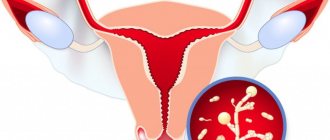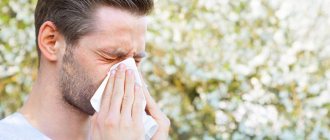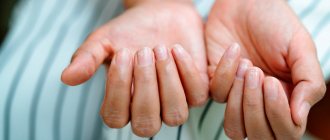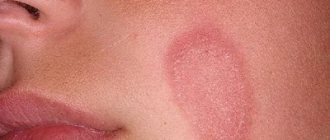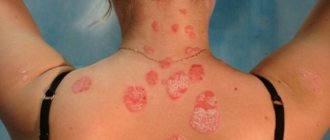Causes of female and male genital allergies
Male sperm. Gynecologists often reported allergies to the genitals in women who had contact with sperm after sex with a man, allergic vulvovaginitis. In this case, there is a burning sensation, red spots, slight itching and swelling. Glycoproteins, which are part of sperm, are in this case an allergen for women.
Spermicides are substances aimed at destroying sperm. For ease of use, they are available in the form of suppositories, foams, tablets, jelly, and are an assistant in avoiding unwanted pregnancy. Nonoxynol-9 is often included in contraceptives, causing allergic reactions on the genitals of women and men. Genital allergies can occur immediately after sexual intercourse using spermicides, or after a certain amount of time (hours, days).
A condom is a barrier type contraception. In most cases, allergies to the genital organs of men and women appear after using latex condoms; a smaller proportion of the symptoms of this allergy occur with polyurethane and rubber condoms. Allergy to the genital organs in men manifests itself in the form of inflammation of the glans and foreskin of the penis (in this case, the affected area is the area of the condom being worn). In women, inflammation of the labia and clitoris, accompanied by slight itching. For the allergy to go away, you should stop using the latex condom.
Antiseptics are medications used after intimate contact to prevent infection and sexually transmitted infections. Such agents are miramistin and chlorhexidine. In the world literature, there are not often descriptions of cases of allergies to the genitals. In those places in Russia where antiseptics are widely used and popular, thanks to modern advertising, there are much more cases of allergic reactions on the genitals among the population. In men, this is expressed as inflammation of the urethra, inflammation of the foreskin and head of the penis (balanopastitis).
The most common allergens are those products that the population uses every day - cosmetics and hygiene products. This includes creams, soaps and deodorants for intimate hygiene. Allergic manifestations after contact with these agents are as follows: the appearance of red spots, rashes, itching of the vulva and scrotum. Refusal of cosmetic and hygiene preparations that cause these symptoms in a person will allow you to get rid of unpleasant sensations in a short time.
Also, allergies to the genitals can be caused by medications used both internally and externally. Sulfonamide drugs used to treat infectious diseases of bacterial origin are typical allergens and appear in the form of spots with clearly defined borders of a bright red color (mostly without pain). Iodine-containing products can also cause an allergic process, accompanied by inflammation of the outer labia, clitoris and vagina of a woman.
Poor-quality underwear, the fabric of which contains synthetic fibers, as well as products made of latex and other types of materials that do not allow air to pass through, can also cause allergies to the genitals. A “greenhouse effect” is created and a feeling of discomfort constantly haunts a person. By purchasing high-quality, hypoallergenic underwear, people who are sensitive to the components of the material will be able to avoid allergic irritation and itching of the skin.
Insect bites, especially those of bees, wasps, and hornets, cause instant swelling (blisters), redness, itching, and swelling in the genital area in the victim. One of the types of fungal infections - candidiasis (thrush) causes different types of allergies in the female and male genital organs. Yeast-like fungi of the Candida species cause the patient to feel itching, burning, redness, and pain during sexual intercourse.
What are the symptoms of allergies?
Allergy symptoms can manifest in different ways. Depending on the location, the following classification is distinguished:
- lower respiratory tract: difficulty breathing, cough;
- eyes: redness, itching, lacrimation;
- upper respiratory tract: “wet”, “dry”, stuffy nose - skin: various manifestations that can range from redness to peeling.
Reactions may also occur in the mouth, with swollen lips or tongue, face and throat. In severe cases, the allergic reaction may manifest as anaphylaxis.
Anaphylaxis or anaphylactic reaction is a very dangerous condition that requires prompt medical attention. It is characterized by severe symptoms, such as difficulty breathing, severe itching, facial redness and a drop in blood pressure to a minimum (collapse), which occur immediately after contact with the allergen.
Non-infectious inflammation
Redness on the foreskin and glans is not always associated with infection. Such diseases are non-contagious - transmission does not occur either through sexual contact or in everyday life. They appear during hypothermia, local irritation of the skin and mucous membranes, as well as due to allergic reactions.
The clinical manifestations of non-infectious balanoposthitis are similar to the symptoms of sexually transmitted diseases, so it is important to get diagnosed and tested
Lichen planus
Lichen planus is a pathology of allergic origin, but its exact cause remains unclear. It appears as purple or white rashes around the head of the penis. They do not cause pain or discomfort, and the disease can be mistaken for candidiasis. Lichen planus should be distinguished from other forms of lichen, which are contagious diseases.
Eczema, psoriasis
Eczema is a complex disease that can develop for several reasons. It occurs as a result of allergic reactions, diseases of internal organs and endocrine glands, including diabetes mellitus, hypothyroidism, and pathologies of the stomach and intestines. Its manifestation can be triggered by non-compliance with hygiene rules and wearing tight underwear made of synthetic fabrics. A small rash appears on the skin of the penis, which then bursts and forms ulcers.
Psoriasis is a chronic pathology, during which periods of remission and relapses are observed. It also manifests itself in the genital area of men in the form of a small rash. At different stages of the disease, the rash will differ:
- stearin stain - painful redness, prone to peeling;
- terminal film - a transparent coating that appears when the scales are removed;
- Bloody dew is a sign of film damage.
The disease can spread to the groin and buttock areas. Patients complain of pain in the external genitalia and urethra. It increases with urination and ejaculation. The skin swells and may itch and sting.
Allergy
Allergies are another reason why genital irritation in men may occur. It is a pathological reaction of the human immune system to contact with any substances. Depending on the type of stimulus, several types are distinguished:
- contact - occurs directly at the point of contact with the allergen (including intimate hygiene products, some types of fabrics);
- medicinal - develops after taking certain medications.
Contact allergies go away on their own after eliminating the irritant. However, if a painful itchy rash has appeared on the skin or mucous membranes, it must be treated with external means.
Dermatitis as a symptom of systemic diseases
Many systemic diseases have a wide range of symptoms. They also manifest themselves as dermatitis on various parts of the body and on the genitals. Patients also complain of a general deterioration in health and additional symptoms characteristic of a particular disease.
Redness of the skin and mucous membranes can be observed with the following pathologies:
- diabetes mellitus;
- inflammatory and ulcerative lesions of the digestive tract;
- parasite infestations;
- disorders of the thyroid gland.
Dermatitis caused by systemic diseases is a sign of an allergic reaction of the body to helminth toxins or metabolic disorders. Toxic compounds are not excreted, but accumulate in tissues, which is manifested by itching and irritation.
One of the diseases that manifests itself with itching and rash on any part of the body, including the genitals, is atopic dermatitis. It is of autoimmune origin, that is, it is a pathological reaction of the immune system to its own organs and tissues. The process worsens under stress, against the background of infectious diseases and other factors.
Mechanical and chemical effects
Irritation on the head without itching may be a symptom of a mechanical or chemical effect on the skin or mucous membrane. There is always the possibility of chafing your penis during prolonged sex or getting irritated by aggressive detergents. A painful swelling appears on the skin, but a rash does not form. Dryness and redness may be observed in the area of the glans and frenulum of the genital organ, and the mucous membrane begins to crack. Another reason is diaper rash during the hot season when wearing underwear made of synthetic fabrics. They are accompanied by discomfort and aching pain, which intensifies with movement.
Subcutaneous ASIT
In subcutaneous immunotherapy, allergens are injected into the subcutaneous tissue (usually the arm) every 7-14 days in increased doses until the maximum tolerated concentration is reached, which may vary depending on the drug and the patient's sensitivity. With traditional injectable medications, the patient must visit a doctor monthly for injections, while some new immunotherapy injections require only a few treatments (eg, 4 preseason annual injections) to achieve improvement in more than 90% of patients, with high rates safety and adherence to therapy.
These time-optimized treatment regimens are made possible, among other things, by the use of allergens (allergens modified and optimized in structure) and adjuvants—substances that increase the effectiveness of immunotherapy. In particular, the latter guarantee a high level of therapy effectiveness with maximum ease of use for the doctor and the patient.
For example, for pollen allergies, treatment is usually carried out before the start of the pollen season: for tree pollen - from August to December, and for grass pollen - from October to March. Specific immunotherapy, either sublingual or subcutaneous, rarely causes side effects, such as mild symptoms due to local reactions at the injection site (itching at the injection site, tingling in the mouth). In this case, the specialist will advise adjusting the dose the patient will take.
The treatment cycle in both cases lasts a total of 3 to 5 years, which is necessary to maintain the clinical benefit obtained after cessation of treatment.
Consultation with a doctor is required
If the cause of the development of itching and rash lies in the action of one or another microorganism, complex treatment is prescribed, consisting of taking an antihistamine and an antibiotic or antiviral agent.
Antihistamines (tavegil, suprastin) are used to relieve discomfort during therapy, since sometimes identifying the type of microorganism and its elimination take quite a long time. Antibacterial drugs are used both topically (for example, using clotrimazole cream to treat candidiasis) and orally or intramuscularly. For some diseases, douching of an antibiotic solution directly into the urethra is prescribed. Sometimes, when treating some other diseases not related to the reproductive system, if a rash occurs, including on the genitals, stopping the drug is enough to improve the condition.
In some cases, especially when condylomas develop on the surface of the penis, their surgical removal is required. If assistance is not provided, there is a significant risk of these condylomas degenerating into cancer (human papillomavirus infection is considered a precancerous disease). If you delay in providing help, in the most severe cases, amputation of the penis may be required. If surgical intervention is not advisable (old age or serious condition of the patient), you can limit yourself to courses of radiation and chemotherapy in parallel with taking antiviral drugs.
If the cause of the development of itching and rash is of an allergic nature, typical antiallergic therapy is prescribed - most often antihistamines, some infusion solutions, and vitamin complexes are used.
Each of them has its own role - antihistamines promote competitive binding to histamine receptors, preventing it from causing all allergic manifestations; the role of infusion solutions (sodium chloride, Ringer's solution, Trisol, Acesol) is to dilute the blood plasma and reduce the concentrations of circulating antigens; vitamin preparations are intended to normalize the immune system and the normal course of its reactions (since when an allergy develops, the immune response is usually excessively strong). Most often, several sessions of such treatment are enough to eliminate all existing symptoms.
The use of glucocorticoids for the treatment of these diseases is advisable only in the case of local application and their effect. When glucocorticoids are administered systemically, the benefits of their use are often much less than the consequences that may occur while taking them.
The use of physiotherapeutic methods has not particularly justified itself. More or less effective methods used to strengthen local immunity are UHF therapy and the use of a bioptron. These procedures contribute to the activation of local immunity and its correction in case of possible violations. Most often they are used during the rehabilitation period to quickly restore all body functions.
Sublingual ASIT
With sublingual immunotherapy, the allergen is held under the tongue for a short time (1-2 minutes) and then swallowed. If injections are avoided with this treatment (usually daily), then in order for it to be effective, the patient must remember to take the vaccine daily, and this requires adherence to the therapy regimen. This method is well tolerated, so after initial treatment in an outpatient setting, it can be continued at home. This type of therapy is a good option for patients who are afraid of injections, for children, and for people who, due to work or living conditions, have difficulty getting regular injections in the doctor's office.
Treatment
The main point of solving the problem is to find the right approach to treating the disease and preventing relapses. Doctors recommend using comprehensive measures and not limiting therapy only to antiviral drugs. Local treatment eliminates the problem of skin infection, but since the virus is inside the male body, it is necessary to act on herpes from the inside as well. For this, the following drugs are prescribed:
- Antiherpetic drugs effectively combat both exacerbations of the disease and complications that arise against its background.
- Antiviral drugs - interferon and acyclic nucleosides: Acyclovir, Famciclovir. Interferon destroys the active form of the virus in the body, nucleosides disrupt the spread of the herpes virus, eliminate itching, burning, pain, reduce the formation of pustules, and facilitate the healing of ulcers. The drugs are produced in the form of tablets, intravenous solutions, creams and ointments for treatment.
- Immuno-strengthening agents – increase a man’s body’s resistance and strengthen his protective properties.
- General strengthening herbal preparations: ginseng, echinacea, eleutherococcus. Immunoglobulin solutions reduce the frequency of subsequent relapses.
- Vitamin therapy.
- Local preparations for treating rashes: Panivir gel - prevents the spread of infection to healthy skin areas and mucous membranes, Viferon gel and Viferon ointment - quickly relieve skin manifestations, Herpeferon ointment - for effective pain relief and reduction of symptoms during exacerbation.
- Physiotherapy.
It is completely impossible to get rid of the genital herpes virus, therefore the main goal of treatment therapy is to reduce the acute stage of the pathology and prolong remission. During the acute phase of genital infection, it is necessary to exclude sexual contact, as there is a risk of infection of the sexual partner. The virus has the ability to be transmitted regardless of contraception.
The result of therapy is the elimination of the symptoms of the disease and its transfer into remission. For recurrent herpes, which flares up more than six times within a month, preventive therapy from a urologist is required to increase the period of remission. Complex treatment will prevent the pathology from passing into the acute stage and will avoid various complications and recurrence of symptoms.
During drug therapy, a man needs to eliminate alcohol, change his diet, and not eat sweet, spicy, pickled, or fatty foods. It is also recommended to go on a plant-based and dairy-based diet and consume maximum fluids.
Before curing herpes, you should improve your health by normalizing your lifestyle. In particular, you should:
eliminate alcohol consumption; refuse intimacy for a while; start wearing loose underwear made from natural fabrics; Wash your genitals regularly using antibacterial soap; pay attention to any signals from the body that indicate new symptoms or complications of the disease.
Traditional treatment for genital herpes can be supplemented by taking vitamins from group B and C, which will help speed up the healing of ulcers left after rashes and stimulate skin regeneration. Vitamin E is also useful, which is applied in the form of an oil solution to the affected areas of the penis to relieve the main symptoms, that is, pain, itching and burning.
First aid
First aid is carried out for a complex and dangerous condition of an allergic reaction - anaphylaxis. What to do if you suspect anaphylactic shock:
- Call for medical help immediately.
- Prevent further entry of the allergen into the body.
- While waiting for medical assistance, the patient should be placed in a shock-proof position: lay the person on his side, ensure the airway is open (pull out the lower jaw), raise his legs by about 30 cm (for example, using a chair). If possible, the patient should be positioned so that the head is lower than the knees and pelvis. This position, called Trendelenburg, is particularly beneficial as it promotes venous return to the vital organs (heart and brain) through the simple effect of gravity.
- While awaiting medical attention, a person suffering from anaphylactic shock should be kept as reassured as possible.
- Although drug therapy is the sole responsibility of the physician, it is useful for the rescuer to know the general course of action. The life-saving drug for anaphylactic shock is adrenaline (or epinephrine), administered intravenously, preferably in a slow and continuous manner. But in critical cases, adrenaline should be immediately administered intramuscularly. Additional medications may be required due to the state of functional disorders of the relevant organs.
- While in milder cases the combined use of epinephrine and antihistamines is generally sufficient, in more serious cases the airway should be maintained, with oxygen therapy or surgery if necessary.
Prevention
It is possible to avoid inflammatory processes in the genital organs; you just need to be careful about hygiene procedures and do not neglect preventive examinations by a specialist. Boys should be observed as follows: until the age of 4-5 years, the head of the penis must be open, otherwise phimosis may develop and the baby should be urgently shown to a doctor.
Good quality underwear that fits, trousers that are not tight, gel for intimate hygiene and washing the genitals twice a day, as well as after each sexual intercourse, examination by a urologist once every 6-12 months - these are all the principles for the prevention of diseases of the penis in men.
List of effective drugs
Modern pharmacology offers a significant number of medications aimed at eliminating inflammatory processes in men. Depending on the severity of the symptoms, the attending physician prescribes the following medications:
- Anti-inflammatory drugs. These include antibacterial ointments, creams, and solutions. When applied correctly and regularly, they relieve inflammation.
- Painkillers. Burning, itching and irritation of the foreskin in men can be treated with painkillers.
- Regenerative drugs. They have a regenerating effect, thanks to which you can get rid of cracks on the penis.
- Antimicrobial and antifungal medications. These drugs suppress the activity of pathogenic microorganisms, that is, inflammation of an infectious nature.
Let's take a closer look at the most common and effective drugs that help relieve inflammation and pain during balanoposthitis.
Zinc ointment
This drug has antimicrobial and anti-inflammatory effects. Prescribed for the treatment of inflammation of the foreskin caused by infection. Regular use of Zinc ointment helps get rid of swelling, redness and irritation, and this medicine also has a drying effect.
Pimafucin
This is an antifungal ointment that is prescribed for balanoposthitis caused by the active development of pathogenic microorganisms. Pimafucin is one of the most gentle antifungal drugs on the modern pharmacological market, and therefore does not cause side effects.
Triderm
This is a combination drug that contains antimycotics, glucocorticosteroids and antibiotics. It is highly effective even in severe cases of balanoposthitis. Triderm helps eliminate the unpleasant symptoms that accompany the disease and also have a detrimental effect on the cause of its development.
Batrafen
One of the most effective antifungal drugs, but is highly effective only in the early stages of the inflammatory process. In such cases, Batrafen quickly relieves inflammation, thereby relieving symptoms such as itching, burning, and irritation on the penis.
Fluconazole
This medication is available in the form of tablets and ointments. Both types of Fluconazole have a pronounced antifungal effect. In a short time it relieves inflammatory processes, as well as unpleasant symptoms of balanoposthitis in the form of burning, itching, irritation, swelling. It also has a calming effect at the local level.
Dermozolon
This drug is prescribed for the treatment of erosive and simple balanoposthitis. Also helps fight fungal and viral infections. It has a healing, anti-inflammatory and anti-allergic effect when applied topically.
Levomekol
This product is available in the form of a gel for topical use. Relieves inflammatory processes caused by fungal and bacterial infections. Levomekol is an antibacterial drug, so the recovery process takes a short period of time. Has an antiseptic effect.
Clotrimazole
Helps fight inflammation of the glans and foreskin in men caused by the active activity of yeast fungi. Quickly relieves inflammatory processes, thereby eliminating unpleasant symptoms.
Miramistin
Available in various forms, but for the treatment of inflammation of the foreskin in men it is used as a solution. It is highly effective in the development of balanoposthitis against the background of certain sexually transmitted diseases.
The following topical medications also help fight inflammatory processes: Nizoral, Lokasalen, Synthomycin ointment, etc.
Important to remember! You can use medications for inflammation of the foreskin only after the appointment of your doctor!
Infections
One of the most common diseases of the penis is a fungal infection. The cause of mycosis of the penis is an infection of the genital skin with fungi of the species Candida albicans. It is more common in people with immune disorders, chronic antibiotic use, diabetes and cancer. Mycotic changes are promoted by: poor hygiene of the perineal area and excessive use of cosmetics in these areas. The infection can be transmitted from a partner/sexual partner, sanitary equipment (swimming pools, toilets), towels and other objects with a favorable environment for the development of fungi. Symptoms of the disease:
- the appearance of red papules and pustules on the penis;
- itching and redness;
- A white coating with a specific odor appears on the head.
In addition, the disease is usually accompanied by swelling and pain. Treatment uses topical and oral antifungal drugs.
Types of rashes on the penis
» alt=»»>
This type of rash is not a symptom of any disease and may only represent an aesthetic problem. If necessary, it can be easily removed with a laser in specialized clinics. Unlike white, red rash is a sign of pathology and requires immediate treatment.
In addition, a man with such manifestations on the penis can be a source of infection, so he should immediately stop all sexual intercourse and consult a doctor. There are several main causes of such lesions: Inflammation of the sebaceous glands on the head. Usually appears in adolescence in the form of acne, consisting of red dots.
Allergic reaction. In this case, a red rash can occur from exposure to a variety of irritating factors - hygiene products, unsuitable material of condoms or underwear, the vaginal environment of a woman who has become a new sexual partner, etc.
Fungal infections. If the pathological processes are caused by fungi, most often a red rash appears on the head, less often red dots form on the skin of the penis. In addition to these reasons, a red rash is the most common primary manifestation of sexually transmitted diseases (STDs).
But in this case, it changes very quickly and acquires specific signs characteristic of each specific infection. If a man has diabetes, a small rash may appear on the head of his penis as a sign of a concomitant disease - balanoposthitis.
This pathology is caused by the development of an inflammatory process affecting the head and foreskin. The reason is decreased immunity and excess sugar in the urine, which leads to the proliferation of pathogenic microorganisms.
In such situations, a rash on the penis is only an external manifestation of the disease, which is characterized by a long course and complex treatment, including surgical removal of the foreskin. To reduce the number and severity of rashes, topical medications can be used.
Localization of lesions
In addition to the nature and type, the rash differs in location. Typically, rashes appear around the penis, on the head and skin. In rare cases, the rash covers the entire genital organ. Rashes around the penis occur in several cases.
At the initial stage of the disease; with hormonal disorders; during an exacerbation of a chronic disease; as an external manifestation of inflammation of the genitourinary system. This rash usually goes away on its own within 2 weeks. Otherwise, it requires diagnosis and treatment.
Usually a red rash or red dots form on the head or along its edge, which then merge into red spots. They are accompanied by swelling, itching, soreness and a whitish coating. Allergies manifest themselves somewhat differently - in the form of dry, dense tubercles. It is also the head that is often affected by genital herpes, which is characterized by rashes in the form of itchy blisters.
Another type of rash can appear in teenagers - they often develop acne along the edge of the head. The problem can become significantly worse if infection penetrates into the pearlescent glands. The skin of the male genital organ is very susceptible to infection.
All kinds of rashes on the skin of the penis appear: as an independent disease; as a manifestation of venereal disease; as a result of the spread of signs of a dermatological problem. In any case, such rashes are a serious reason to visit a dermatologist-venereologist.
Risk factors
1. Heredity. Atopy, a genetic predisposition to develop allergic reactions when ingesting or inhaling allergens, is more common in families with members who suffer from allergies. This does not mean that according to Mendelian laws, food allergies are passed on from generation to generation, but statistically it is clear that children of allergic parents are more likely to have allergies. It has been estimated that the risk of atopy in a child with both parents having allergies is 47 to 100%, compared with 13% in children without a family history.
However, this heredity has some features:
- Symptoms can vary significantly from parent to child, both in severity and location (for example, a parent, at the time of an allergic reaction, will complain of breathing problems, while the child suffers from a skin rash);
- Allergies can develop to completely different antigens. For example, a parent may have a medication allergy, while a child may develop sensitivity to pollen or food.
2. Exposure to antigens.
Every time the body comes into contact with an antigen, i.e. a protein that is not its own, it produces antibodies against it. Theoretically, our body should therefore react and produce antibodies against all food proteins, since food represents direct contact with the external environment. Fortunately, this happens with pathogens but not with food, because the immune system recognizes food proteins as foreign but harmless substances through a mechanism called tolerance, which involves the intestinal mucosa and associated lymphoid tissues (called GALT, abbreviation Gut Associated Lymphoid Tissue). Due to this mechanism, most people can eat any food without experiencing an allergic reaction.
In the presence of damage to the intestinal mucosa (pathologies of the gastrointestinal tract of inflammatory origin, infections, malabsorption, etc.), insufficient digestive action of proteolytic enzymes or a weakened immune system, high molecular weight protein fragments can reach the systemic level, stimulating the synthesis of type E immunoglobulins. In this case, an initial sensitization occurs, followed by actual allergic reactions in combination with future food consumption.
Possible diseases
I would like to start with the fact that some rashes on the head in men without itching appear in adolescence and can be confused with harmless pathologies that do not require any treatment or removal:
- . A common phenomenon among men, occurring in 25-45% of cases. The peak occurs during puberty, when small grain-sized lesions appear around the head of the penis. They do not hurt, do not itch or bleed. Soft to the touch, slightly raised above the surface of the skin. The number of rashes can reach several dozen. With age, the size may increase, but rarely exceeds 2-3 mm. Localization - over the entire surface of the head and foreskin.
- Contact dermatitis. Oddly enough, but a very common phenomenon not only among teenagers, but also adult men aged 25-40 years. The reason is commonplace - an allergic reaction to synthetics (underwear and bed linen), detergents (soap, shower gel), personal hygiene products (loofah) and other substances. Very often, rashes on the head in the form of red spots appear from condoms or their lubricant. Also, the reason may lie in the use of various types of lubricants.
- . This is a fungal disease, which is characterized by a chronic, relapsing course. It is also called male thrush because it is caused by fungi of the genus Candida. The main symptom is the appearance of red rashes on the head of men, which can resolve spontaneously, which makes timely detection of the disease very difficult, since many are confident that they are completely healthy, since there are no visible disorders. Very often, thrush in men also manifests itself in the form of a sour odor and severe itching along the entire length of the penis. Less commonly, pain may occur during urination. It is transmitted sexually and can also be “intensified” after prolonged use of antibiotics.
- Fordyce granules. They look like white rashes on the head and along the entire length of the penis in men. They usually appear at the age of 13-20 years. Many people confuse them with white pimples of viral origin, but doctors assure that Fordyce granules are absolutely benign formations that are not transmitted from one person to another and do not pose a threat to health. Their appearance is not accompanied by any subjective sensations. When pressed, a whitish mass of thick consistency may be released.
- Gonorrhea. A very common sexually transmitted disease (in 95% of cases). But here the main symptoms are cutting pain during urination and purulent discharge from the urethra when pressed. Then red rashes appear on the head, usually around the urethra, and unbearable itching. The disease is dangerous for both sexes, as it can cause the development of secondary infections (in 35-60% of cases) and lead to infertility. Chronic forms can be asymptomatic, which leads to the fact that the patient, without knowing it, can infect other people for a long time.
- . Common formations of viral origin (genital warts are based on the human papillomavirus), which can be localized on the head, foreskin and along the entire length of the male penis. The quantity usually does not exceed 5-7 pieces. Size 3-5 mm, less often 10-15 mm. Distinctive features are flesh-colored or dark brown, a “warty” appearance and the absence of subjective sensations (provided that the formations are not localized near the urethra). Transmitted sexually.
- Urogenital chlamydia. Another common sexually transmitted disease, which is 10 times more common than gonorrhea and 7 times more common than syphilis. Almost always occurs simultaneously with other sexually transmitted infections (gonorrhea, gardnerella, trichomonas and ureaplasma). The main symptoms are gray and yellow purulent discharge from the urethra (usually in the morning), cutting pain during urination, cloudy urine and rashes on the head, accompanied by swelling and moderate itching. Chlamydia poses a serious danger to men and women, as it can cause serious complications, manifested in the form of erection problems, premature ejaculation and ultimately leading to infertility.
Separately, I would like to say about syphilis, which very rarely, but still, manifests itself in the form of pinpoint rashes on the head in men. Most often they are observed with primary and secondary syphilis and can be present on the skin and mucous membranes for 20-40 days.
Diagnostics
Establishing the causes of hypersensitivity is the responsibility of a urologist-andrologist. If an STI or allergic dermatitis is suspected, a dermatologist-venereologist or allergist is involved in the examination. During the interview, the doctor finds out when the symptom first appeared, whether its appearance was preceded by any diagnosed diseases or unusual changes in the head.
During an external examination, the mobility of the prepuce is assessed, signs indicating the possible nature of the disorder are identified: swelling, hyperemia, cracks, blisters, the presence of pathological discharge, enlargement of regional lymph nodes. In the absence of external changes to differentiate hypersensitivity and other causes of erectile dysfunction, the patient is offered a lidocaine test.
The essence of the manipulation is to apply 10% lidocaine to the head of the penis 10-15 minutes before sexual intercourse. You should have sex with a condom. If, according to the results of 3-5 tests, the duration of the act has significantly increased, this indicates hypersensitivity. If pathological symptoms are detected, laboratory tests are prescribed.
The basic examination is smear microscopy. If a large number of bacteria and leukocytes are detected, ELISA or PCR is performed to exclude specific infections, microbiological analysis to determine the nature of the microflora and sensitivity to antibiotics. Tests are prescribed for syphilis and HIV infection. For dermatitis, allergy tests are performed and the level of immunoglobulins is assessed.
Urological examination
